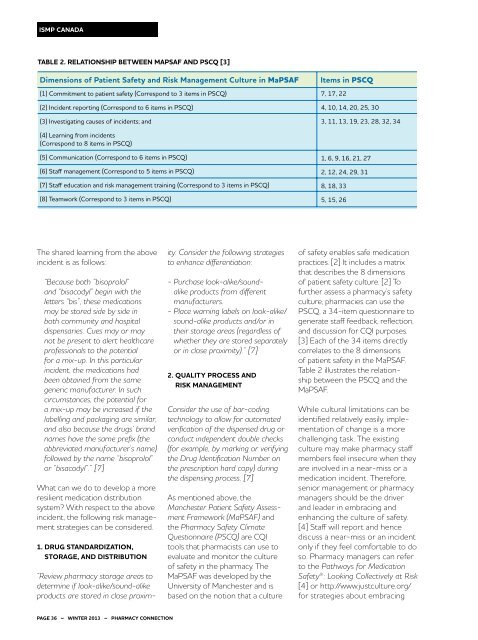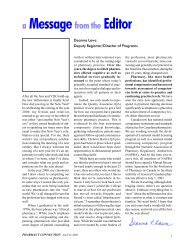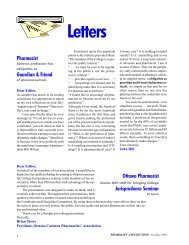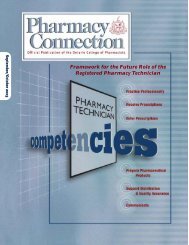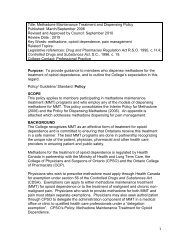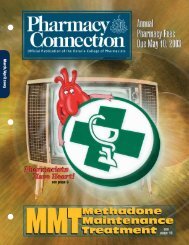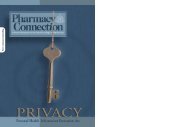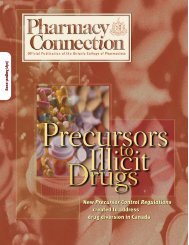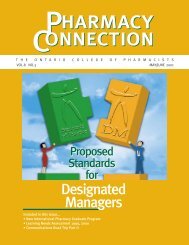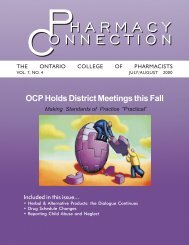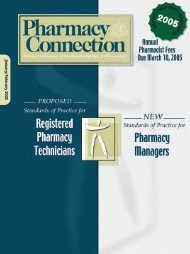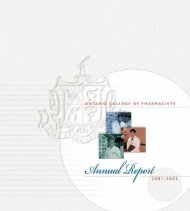Download - Ontario College of Pharmacists
Download - Ontario College of Pharmacists
Download - Ontario College of Pharmacists
Create successful ePaper yourself
Turn your PDF publications into a flip-book with our unique Google optimized e-Paper software.
ISMP CANADA<br />
The shared learning from the above<br />
incident is as follows:<br />
“Because both “bisoprolol”<br />
and “bisacodyl” begin with the<br />
letters “bis”, these medications<br />
may be stored side by side in<br />
both community and hospital<br />
dispensaries. Cues may or may<br />
not be present to alert healthcare<br />
pr<strong>of</strong>essionals to the potential<br />
for a mix-up. In this particular<br />
incident, the medications had<br />
been obtained from the same<br />
generic manufacturer. In such<br />
circumstances, the potential for<br />
a mix-up may be increased if the<br />
labelling and packaging are similar,<br />
and also because the drugs’ brand<br />
names have the same prefix (the<br />
abbreviated manufacturer’s name)<br />
followed by the name “bisoprolol”<br />
or “bisacodyl”.” [7]<br />
What can we do to develop a more<br />
resilient medication distribution<br />
system? With respect to the above<br />
incident, the following risk management<br />
strategies can be considered.<br />
1. Drug Standardization,<br />
Storage, and Distribution<br />
“Review pharmacy storage areas to<br />
determine if look-alike/sound-alike<br />
products are stored in close proximity.<br />
Consider the following strategies<br />
to enhance differentiation:<br />
- Purchase look-alike/soundalike<br />
products from different<br />
manufacturers.<br />
- Place warning labels on look-alike/<br />
sound-alike products and/or in<br />
their storage areas (regardless <strong>of</strong><br />
whether they are stored separately<br />
or in close proximity).” [7]<br />
2. Quality Process and<br />
Risk Management<br />
Consider the use <strong>of</strong> bar-coding<br />
technology to allow for automated<br />
verification <strong>of</strong> the dispensed drug or<br />
conduct independent double checks<br />
(for example, by marking or verifying<br />
the Drug Identification Number on<br />
the prescription hard copy) during<br />
the dispensing process. [7]<br />
As mentioned above, the<br />
Manchester Patient Safety Assessment<br />
Framework (MaPSAF) and<br />
the Pharmacy Safety Climate<br />
Questionnaire (PSCQ) are CQI<br />
tools that pharmacists can use to<br />
evaluate and monitor the culture<br />
<strong>of</strong> safety in the pharmacy. The<br />
MaPSAF was developed by the<br />
University <strong>of</strong> Manchester and is<br />
based on the notion that a culture<br />
<strong>of</strong> safety enables safe medication<br />
practices. [2] It includes a matrix<br />
that describes the 8 dimensions<br />
<strong>of</strong> patient safety culture. [2] To<br />
further assess a pharmacy’s safety<br />
culture, pharmacies can use the<br />
PSCQ, a 34-item questionnaire to<br />
generate staff feedback, reflection,<br />
and discussion for CQI purposes.<br />
[3] Each <strong>of</strong> the 34 items directly<br />
correlates to the 8 dimensions<br />
<strong>of</strong> patient safety in the MaPSAF.<br />
Table 2 illustrates the relationship<br />
between the PSCQ and the<br />
MaPSAF.<br />
While cultural limitations can be<br />
identified relatively easily, implementation<br />
<strong>of</strong> change is a more<br />
challenging task. The existing<br />
culture may make pharmacy staff<br />
members feel insecure when they<br />
are involved in a near-miss or a<br />
medication incident. Therefore,<br />
senior management or pharmacy<br />
managers should be the driver<br />
and leader in embracing and<br />
enhancing the culture <strong>of</strong> safety.<br />
[4] Staff will report and hence<br />
discuss a near-miss or an incident<br />
only if they feel comfortable to do<br />
so. Pharmacy managers can refer<br />
to the Pathways for Medication<br />
Safety®: Looking Collectively at Risk<br />
[4] or http://www.justculture.org/<br />
for strategies about embracing<br />
PAGE 36 ~ WINTER 2013 ~ PHARMACY CONNECTION


